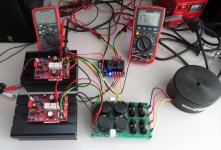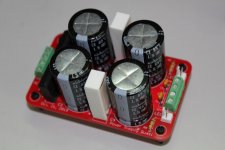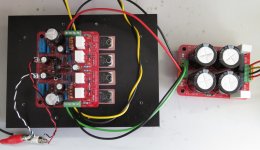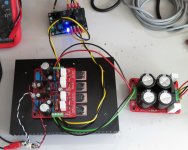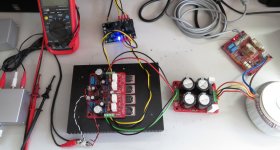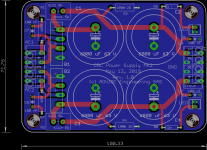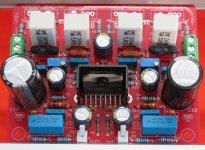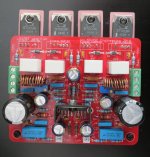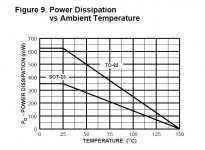After several test made with some friends with the amplifier using a single pair on one channel we didn't find a difference between both channels 😕
For a simple listening at home on 8 ohms speaker I would recommend to use only a single pair for the output, the dual pair could be useful if you are using 4 ohms speaker and play music at very high level !
To finish my amplifier I added the second pair anyway to have a symmetric design... It is now playing since two weeks with 42 V DC power supply and did not become too hot, except for the driver T7, may be it could have been interesting to use a 2SA1381 for the VAS like in the Quasi ?
I am very impressed by the quality of these two small and simple amplifiers and I want to thanks Mooly and Ranchu32 for their nice design 😉 I am currently building the very successful RMI-FC100 from Roender, thank to Harry (Cambe) who send me the PCB, and It is much more complicated, if it sound better that will be terrible, I may need to buy new speakers 😀
After that, and the hybrid that I am building with the help of Hugh, I will be going back to a tube amplifier with the Quad KT120 that I have waiting for one year already 🙁
Rgds,
Marc
For a simple listening at home on 8 ohms speaker I would recommend to use only a single pair for the output, the dual pair could be useful if you are using 4 ohms speaker and play music at very high level !
To finish my amplifier I added the second pair anyway to have a symmetric design... It is now playing since two weeks with 42 V DC power supply and did not become too hot, except for the driver T7, may be it could have been interesting to use a 2SA1381 for the VAS like in the Quasi ?
I am very impressed by the quality of these two small and simple amplifiers and I want to thanks Mooly and Ranchu32 for their nice design 😉 I am currently building the very successful RMI-FC100 from Roender, thank to Harry (Cambe) who send me the PCB, and It is much more complicated, if it sound better that will be terrible, I may need to buy new speakers 😀
After that, and the hybrid that I am building with the help of Hugh, I will be going back to a tube amplifier with the Quad KT120 that I have waiting for one year already 🙁
Rgds,
Marc
Attachments
 nice work.
nice work.Really pleased you have got these up and running and are liking the results.
The driver transistor and its PNP current source do get hot but in practice are only dissipating around 300mw each in quiescent state and so should be well within maximum ratings.
Excellent 🙂
Marc,
Thanks for sharing updates on your project. 🙂
A few follow up questions for you:
1. Did you use +/- 42V on single-pair channel too, or dropped down the voltage?
2. What speakers did you use for your listening tests?
3. How do you find the sound subjectively vs the BH tube amp variants and other solid-states amps you have built?
Cheers,
Zia
Thanks for sharing updates on your project. 🙂
A few follow up questions for you:
1. Did you use +/- 42V on single-pair channel too, or dropped down the voltage?
2. What speakers did you use for your listening tests?
3. How do you find the sound subjectively vs the BH tube amp variants and other solid-states amps you have built?
Cheers,
Zia
Hello Marc, Congrats on successful build in stereo.
If you plan on making this permanent with a case, then do include the inductor in series with output as per sch.
regards
Prasi
If you plan on making this permanent with a case, then do include the inductor in series with output as per sch.
regards
Prasi
Hi,
Thanks for your feedback 🙂
Zia,
1) I have used 30 V DC for the first test, and 35 V later. Since one week all test were done with 42 V DC with both version 1 or 2 pairs.
2) The amplifier was tested with basic Yamaha bookshelf speaker at the beginning and with Alon "Petites" for serious listening later : Acarian Alon Petite loudspeaker & PW-1 woofer system | Stereophile.com (see previous post)...
3) The sound is very good, it is very similar to the Quasi, it is "tube like" but if it is driving the speaker with more control in the bass than tubes, it did not have the tube sweetness of the Baby Huey in the mid 😎
A very good amplifier
Cheers,
Marc
Thanks for your feedback 🙂
Zia,
1) I have used 30 V DC for the first test, and 35 V later. Since one week all test were done with 42 V DC with both version 1 or 2 pairs.
2) The amplifier was tested with basic Yamaha bookshelf speaker at the beginning and with Alon "Petites" for serious listening later : Acarian Alon Petite loudspeaker & PW-1 woofer system | Stereophile.com (see previous post)...
3) The sound is very good, it is very similar to the Quasi, it is "tube like" but if it is driving the speaker with more control in the bass than tubes, it did not have the tube sweetness of the Baby Huey in the mid 😎
A very good amplifier

Cheers,
Marc
Hi Marc,
Very nice work. Are you planning to document your build work for the RMI-FC100 on the forum. I also have one to build, and one can never gain enough knowledge when it comes to building.
Myles
Very nice work. Are you planning to document your build work for the RMI-FC100 on the forum. I also have one to build, and one can never gain enough knowledge when it comes to building.
Myles
Marc,
Great result, and maybe more than you expected?
The midrange of the Baby Huey is probably because with tubes you have very strong H2. Your new amp has global feedback and the effect of the tube is reduced. I would expect H2 to be around -75dB down, when the Huey was probably around -65dB.
Thank you for sharing this nice amp with us.
Hugh
Great result, and maybe more than you expected?
The midrange of the Baby Huey is probably because with tubes you have very strong H2. Your new amp has global feedback and the effect of the tube is reduced. I would expect H2 to be around -75dB down, when the Huey was probably around -65dB.
Thank you for sharing this nice amp with us.
Hugh
Another factor
If the bass for some reason does not attract your focus you hear better misd. Usually, tubes have better misd but many of them have bass problem (slower, rounded, softer, etc) or just OK in that department. Only would be fair to compare amps like tube and SS if you bring the bass to the same level even if that means, for example, you use an active sub. I am not talking to use a subwoofer in the long term just for comparing the two amp fairly.
If the bass for some reason does not attract your focus you hear better misd. Usually, tubes have better misd but many of them have bass problem (slower, rounded, softer, etc) or just OK in that department. Only would be fair to compare amps like tube and SS if you bring the bass to the same level even if that means, for example, you use an active sub. I am not talking to use a subwoofer in the long term just for comparing the two amp fairly.
I am still listening the amplifier while I am building the two C-R-C modules (the same that I have made for the Quasi, see photo) that will be used with the amplifier in this enclosure : DIY Case Amplifier 100% Aluminium 271x240x90mm - Audiophonics ...
May be one other reason why the bass are not too loud is that I am still using bookshelf speaker until now, I really need to move these amplifiers on my big floor Focal Electra 936 & 926 standing speakers Focal Electra 936 Floorstanding Speakers user reviews : 4.7 out of 5 - 2 reviews - audioreview.com 🙂
Myles, the RMI-FC100 is much more complicated to build, mainly with the original PCB which does not include serigraph and have very small pattern for components, I will put picture on the Roender thread RMI-FC100, a single stage audio power amplifier when I will be more advanced...
Cheers,
Marc
May be one other reason why the bass are not too loud is that I am still using bookshelf speaker until now, I really need to move these amplifiers on my big floor Focal Electra 936 & 926 standing speakers Focal Electra 936 Floorstanding Speakers user reviews : 4.7 out of 5 - 2 reviews - audioreview.com 🙂
Myles, the RMI-FC100 is much more complicated to build, mainly with the original PCB which does not include serigraph and have very small pattern for components, I will put picture on the Roender thread RMI-FC100, a single stage audio power amplifier when I will be more advanced...
Cheers,
Marc
Attachments
Hi,
My MOSFET amplifier made for music designed by Mooly is at Philippe home for the final integration in the enclosure, he is living not very far from me, also in the south of France, close to the little town of Bandol well known for the wine produced here I am lucky that Philippe is very smart in mechanical job because I am very bad for that 😡 Before I meet him (thanks to Internet Audio forums...) I had plenty of electronic boards assembled and working but not packaged !
I am lucky that Philippe is very smart in mechanical job because I am very bad for that 😡 Before I meet him (thanks to Internet Audio forums...) I had plenty of electronic boards assembled and working but not packaged !
Finally Philippe who has also made the final integration for my Quasi will keep the two small CRC power supply modules for his own Quasi project, therefor I had the opportunity to redesign a slightly larger CRC board for the Mooly amplifier since it use a bigger enclosure (see previous post). The new board will have the same height than the Mooly amplifier board designed by Prasi and will fit nicely close to it on the heatsink. With the bigger PCB I was able to put 30 mm diameter capacitor instead of 25 mm, it is possible to use 10'000 uF 50 V or 6'800 uF 63 V (what I am using now) which should be enough for most amplifiers...
Since the Mooly amplifier is no more here, I tested the power supply with an other small amplifier that I have designed to use some LM4702 (now obsolete) and Sanken STD03 that I had in stock. I have designed a first version 10 years ago but I made several mistakes and the ground was not well routed and I had some noise 🙁
This version is much better, I have no noise at all and the sound is very good, may be not as transparent and clear as the Quasi or the Mooly but it is a very simple and very compact amplifier to build (it is a stereo board !). If someone is interested and have some LM4702 in stock, it is possible to get the board from PCBWay because I share the design : LM4702 sanken amplifier - Share Project - PCBWay
When the Mooly amplifier will be finished, I will put the photos here 🙂 For information I have just ordered 12 Renesas 2SJ162 and 12 2SK1058 from Reichelt because these Lateral MOSFET are still available from them 😀
Cheers,
Marc
My MOSFET amplifier made for music designed by Mooly is at Philippe home for the final integration in the enclosure, he is living not very far from me, also in the south of France, close to the little town of Bandol well known for the wine produced here
 I am lucky that Philippe is very smart in mechanical job because I am very bad for that 😡 Before I meet him (thanks to Internet Audio forums...) I had plenty of electronic boards assembled and working but not packaged !
I am lucky that Philippe is very smart in mechanical job because I am very bad for that 😡 Before I meet him (thanks to Internet Audio forums...) I had plenty of electronic boards assembled and working but not packaged !Finally Philippe who has also made the final integration for my Quasi will keep the two small CRC power supply modules for his own Quasi project, therefor I had the opportunity to redesign a slightly larger CRC board for the Mooly amplifier since it use a bigger enclosure (see previous post). The new board will have the same height than the Mooly amplifier board designed by Prasi and will fit nicely close to it on the heatsink. With the bigger PCB I was able to put 30 mm diameter capacitor instead of 25 mm, it is possible to use 10'000 uF 50 V or 6'800 uF 63 V (what I am using now) which should be enough for most amplifiers...
Since the Mooly amplifier is no more here, I tested the power supply with an other small amplifier that I have designed to use some LM4702 (now obsolete) and Sanken STD03 that I had in stock. I have designed a first version 10 years ago but I made several mistakes and the ground was not well routed and I had some noise 🙁
This version is much better, I have no noise at all and the sound is very good, may be not as transparent and clear as the Quasi or the Mooly but it is a very simple and very compact amplifier to build (it is a stereo board !). If someone is interested and have some LM4702 in stock, it is possible to get the board from PCBWay because I share the design : LM4702 sanken amplifier - Share Project - PCBWay
When the Mooly amplifier will be finished, I will put the photos here 🙂 For information I have just ordered 12 Renesas 2SJ162 and 12 2SK1058 from Reichelt because these Lateral MOSFET are still available from them 😀
Cheers,
Marc
Attachments
mooly amp
Hi mooly can you please show me how to conert your amp to balanced input regards ampman
Hi mooly can you please show me how to conert your amp to balanced input regards ampman
Its not suitable for balanced operation I'm afraid as that really only applies to differential input stages that have similar characteristics between the inverting and non inverting inputs.
The emitter of the input transistor is the inverting input, however the single ended nature of the input stage means its not suitable to be used in a balanced configuration, not least because the DC conditions are always different between the two inputs.
The emitter of the input transistor is the inverting input, however the single ended nature of the input stage means its not suitable to be used in a balanced configuration, not least because the DC conditions are always different between the two inputs.
HI,
Do you know the Q5 dissipation on idle and max output voltage ?
(edit) i found the asc : 268mW idle and 436mW pic with 28V output
it is not to high for a TO92 ?
thanks
Do you know the Q5 dissipation on idle and max output voltage ?
(edit) i found the asc : 268mW idle and 436mW pic with 28V output
it is not to high for a TO92 ?
thanks
Last edited:
Thank you mooly,
in fact if I asked the question is because I would also used TO92 in VAS (BC560) and forumers warned me about the risk of reliability because of them while I had 200mW in idle and 280mW maximum
if you have no problem, I should not have any
in fact if I asked the question is because I would also used TO92 in VAS (BC560) and forumers warned me about the risk of reliability because of them while I had 200mW in idle and 280mW maximum
if you have no problem, I should not have any
Last edited:
Is there any possibility of getting the gerber files for this version with four outputs? Just for home-use of course!
Are Prasi's gerber files for the slimmer width PCB posted somewhere? I couldn't find them in the thread.
mooly amp
Hi mooly, on my first board there is a slight wiggle at the top and bottom of the sine wave which I presume is distortion. Output voltage is good but I can't control the IQ. Second board I can't control the IQ and that is to say it goes way too high whereas the first board I can't increase it at all.
Thanks
Hi mooly, on my first board there is a slight wiggle at the top and bottom of the sine wave which I presume is distortion. Output voltage is good but I can't control the IQ. Second board I can't control the IQ and that is to say it goes way too high whereas the first board I can't increase it at all.
Thanks
- Home
- Amplifiers
- Solid State
- My MOSFET amplifier designed for music

